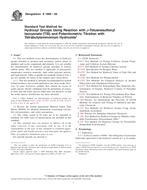We need your consent to use the individual data so that you can see information about your interests, among other things. Click "OK" to give your consent.
ASTM F2714-08(2013)
Standard Test Method for Oxygen Headspace Analysis of Packages Using Fluorescent Decay
STANDARD published on 1.8.2013
The information about the standard:
Designation standards: ASTM F2714-08(2013)
Note: WITHDRAWN
Publication date standards: 1.8.2013
SKU: NS-54417
The number of pages: 4
Approximate weight : 12 g (0.03 lbs)
Country: American technical standard
Category: Technical standards ASTM
The category - similar standards:
Annotation of standard text ASTM F2714-08(2013) :
Keywords:
fluorescence, headspace analysis, oxygen transmission rate, permeability, permeation, residual oxygen, ICS Number Code 71.040.40 (Chemical analysis)
Additional information
| Significance and Use |
|
3.1 The oxygen content of a package’s headspace is an important determinant of the packaging protection afforded by barrier materials. The package under test is typically MAP (modified atmosphere packaging) packaged. 3.2 Oxygen content is a key contributor to off-flavors and spoilage of various products, such as chemicals, food and pharmaceuticals. 3.3 The method determines the oxygen in a closed package headspace. This ability has application in: 3.3.1 Package Permeability Studies—The change of headspace composition over a known length of time allows the calculation of permeation. Since the headspace oxygen is measured as a percentage, the volume of the container’s headspace must be known to allow conversion into a quantity such as millilitres (ml) of oxygen. The use of this approach to measure permeation generally applies to empty package systems only as oxygen uptake or outgassing of contained products could affect results. 3.3.2 Leak Detection—If the headspace contains more oxygen than expected or is increasing faster than expected, a leak can be suspected. A wide variety of techniques can be employed to verify that a leak is present and to identify its location. If necessary or of interest, a leak rate may be calculated with known headspace volume and measured oxygen concentration change over time. 3.3.3 Efficacy of the MAP Packaging Process—If the headspace oxygen concentration is found to be higher than expected soon after packaging, the gas flushing process may not be working as well as expected. Various techniques can evaluate whether the MAP system is functioning properly. 3.3.4 Storage Studies—As the method is non-destructive, the headspace can be monitored over time on individual samples to insure that results of storage studies such as shelf life testing are correctly interpreted. |
| 1. Scope |
|
1.1 This test method covers a procedure for determination of the oxygen concentration in the headspace within a sealed package without opening or compromising the integrity of the package. 1.2 This test method requires that chemically coated components be placed on the inside surface of the package before closing. 1.3 The package must be either transparent, translucent, or a transparent window must be affixed to the package surface without affecting the package’s integrity. 1.4 As this test method determines the oxygen headspace over time, the oxygen permeability can easily be calculated as ingress per unit time as long as the volume of the container is known. 1.5 The values stated in SI units are to be regarded as standard. No other units of measurement are included in this standard. 1.6 This standard does not purport to address all of the safety concerns, if any, associated with its use. It is the responsibility of the user of this standard to establish appropriate safety and health practices and determine the applicability of regulatory limitations prior to use. |
Similar standards:
Historical
1.7.2010
Historical
15.10.2013
Historical
1.4.2008
Historical
1.10.2010
Historical
1.11.2009
Historical
1.10.2008
We recommend:
Updating of laws
Do you want to be sure about the validity of used regulations?
We offer you a solution so that you could use valid and updated legislative regulations.
Would you like to get more information? Look at this page.



 ASTM E1868-10
ASTM E1868-10 ASTM E1877-13
ASTM E1877-13 ASTM E1899-08
ASTM E1899-08 ASTM E1950-10
ASTM E1950-10 ASTM E2027-09
ASTM E2027-09 ASTM E203-08
ASTM E203-08
 Cookies
Cookies
